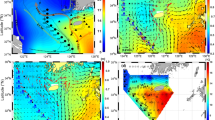Abstract
A winter onshore warm tongue extending from the Yellow Sea Warm Current to the southern Jiangsu coast, and an offshore cold tongue extending from the southern Jiangsu coast to the southwest of Jeju Island (South Korea), are newly identified based on the sea-surface temperature from satellite remote sensing, and further confirmed by the distribution of suspended sediments. In addition, there are two obvious thermal fronts associated with the onshore warm tongue and offshore cold tongue. The narrow gap between the two thermal fronts is supposed to be the pathway for the offshore transport of cold coastal water and suspended sediments. The concurrence of onshore warm and offshore cold tongues suggests the concurrence of onshore and offshore currents in the western Yellow Sea in winter, which seems to be inconsistent with the previously accepted view that, in winter, the Yellow Sea Coastal Current flows from the Old Huanghe Delta to the southwest of Jeju Island. This distinctive phenomenon helps establish an updated view of the circulation in the western Yellow Sea in winter.
Similar content being viewed by others
References
Belkin I M, O’Reilly J E. 2009. An algorithm for oceanic front detection in chlorophyll and SST satellite imagery. Journal of Marine Systems, 78(3): 319–326, https://doi. org/10.1016/j.jmarsys.2008.11.018.
Bian C W, Jiang W S, Greatbatch R J. 2013a. An exploratory model study of sediment transport sources and deposits in the Bohai Sea, Yellow Sea, and East China Sea. Journal of Geophysical Research: Oceans, 118(11): 5 908–5 923, https://doi.org/10.1002/2013JC009116.
Bian C W, Jiang W S, Quan Q, Wang T, Greatbatch R J, Li W. 2013b. Distributions of suspended sediment concentration in the Yellow Sea and the East China Sea based on field surveys during the four seasons of 2011. Journal of Marine Systems, 121–122: 24–35, https://doi.org/10.1016/j. jmarsys.2013.03.013.
Bian C W, Jiang W S, Song D H. 2010. Terrigenous transportation to the Okinawa Trough and the influence of typhoons on suspended sediment concentration. Continental Shelf Research, 30(10–11): 1 189–1 199.
Guan B X. 1994. Patterns and structures of the currents in Bohai, Huanghai and East China Seas. In: Oceanology of China Seas. Springer Netherlands, Dordrecht. p.17–26, https://doi.org/10.1007/978–94–011–0862–1_3.
Hickox R, Belkin I, Cornillon P, Shan Z Q. 2000. Climatology and seasonal variability of ocean fronts in the East China, Yellow and Bohai seas from satellite SST data. Geophysical Research Letters, 27(18): 2 945–2 948, https://doi.org/10.1029/1999GL011223.
Hu C M, Li D Q, Chen C S, Ge J Z, Muller–Karger F E, Liu J P, Yu F, He M X. 2010. On the recurrent Ulva prolifera blooms in the Yellow Sea and East China Sea.Journal of Geophysical Research: Oceans, 115(C5): C05017, https://doi.org/10.1029/2009JC005561.
Ichikawa H, Beardsley R C. 2002. The current system in the Yellow and East China Seas. Journal of Oceanography, 58(1): 77–92, https://doi.org/10.1023/A:1015876701363.
Lie H J, Cho C H, Lee S. 2009. Tongue–shaped frontal structure and warm water intrusion in the southern Yellow Sea in winter. Journal of Geophysical Research: Oceans, 114(C1): C01003, https://doi.org/10.1029/2007JC004683.
Liu D Y, Keesing J K, Xing Q G, Shi P. 2009. World’s largest macroalgal bloom caused by expansion of seaweed aquaculture in China. Marine Pollution Bulletin, 58(6): 888–895, https://doi.org/10.1016/j.marpolbul.2009.01.013.
Lü L G, Wang X, Wang H W, Li L Y, Yang G B. 2013. The variations of zooplankton biomass and their migration associated with the Yellow Sea Warm Current. Continental Shelf Research, 64: 10–19, https://doi.org/10.1016/j.csr. 2013.05.007.
Shi W, Wang M H, Jiang L D. 2011. Spring–neap tidal effects on satellite ocean color observations in the Bohai Sea, Yellow Sea, and East China Sea. Journal of Geophysical Research: Oceans, 116(C12): C12032.
Shi W, Wang M H. 2010. Satellite observations of the seasonal sediment plume in central East China Sea. Journal of Marine Systems, 82(4): 280–285.
Tang Q S, Su J L, Sun S, Zhang J, Huang D J, Jin X S, Tong L. 2005. A study of marine ecosystem dynamics in the coastal ocean of China. Advances in Earth Science, 20(12): 1 288–1 299, https://doi.org/10.3321/j.issn:1001–8166.2005.12.003.(in Chinese with English abstract)
Wang F, Liu C Y, Meng Q J. 2012. Effect of the Yellow Sea warm current fronts on the westward shift of the Yellow Sea warm tongue in winter. Continental Shelf Research, 45: 98–107, https://doi.org/10.1016/j.csr.2012.06.005.
Wang M H, Son S, Harding Jr L W. 2009. Retrieval of diffuse attenuation coefficient in the Chesapeake Bay and turbid ocean regions for satellite ocean color applications. Journal of Geophysical Research: Oceans, 114(C10): C10011.
Wang R, Zuo T. 2004. The Yellow Sea warm current and the Yellow Sea cold bottom water, their impact on the distribution of zooplankton in the southern Yellow Sea. Journal of Korean Society of Oceanography, 39(1): 1–13.
Yuan D L, Hsueh Y. 2010. Dynamics of the cross–shelf circulation in the Yellow and East China Seas in winter. Deep Sea Research Part II: Topical Studies in Oceanography, 57(19–20): 1 745–1 761, http://doi.org/10. 1016/j.dsr2.2010.04.002.
Yuan D L, Zhu J R, Li C Y, Hu D X. 2008. Cross–shelf circulation in the Yellow and East China Seas indicated by MODIS satellite observations. Journal of Marine Systems, 70(1–2): 134–149, https://doi.org/10.1016/j.jmarsys.2007. 04.002.
Zhang F, Sun S, Jin X S, Li C L. 2012. Associations of large jellyfish distributions with temperature and salinity in the Yellow Sea and East China Sea. Hydrobiologia, 690(1): 81–96, https://doi.org/10.1007/s10750–012–1057–5.
Author information
Authors and Affiliations
Corresponding author
Additional information
Supported by the Strategy Program of Chinese Academy of Sciences (Nos. XDA10020104, XDA10020305), the Foundation for Innovative Research Groups of the National Natural Science Foundation of China (No. 41421005), the National Natural Science Foundation of China (Nos. 41476019, 41606040), the NSFC-Shandong Joint Fund for Marine Science Research Centers (No. U1406401), and the High Performance Computing Center, Institute of Oceanology, Chinese Academy of Sciences in Qingdao
Rights and permissions
About this article
Cite this article
Sun, J., Yang, D., Yin, B. et al. Onshore warm tongue and offshore cold tongue in the western Yellow Sea in winter: the evidence. J. Ocean. Limnol. 36, 1475–1483 (2018). https://doi.org/10.1007/s00343-018-7021-0
Received:
Accepted:
Published:
Issue Date:
DOI: https://doi.org/10.1007/s00343-018-7021-0



